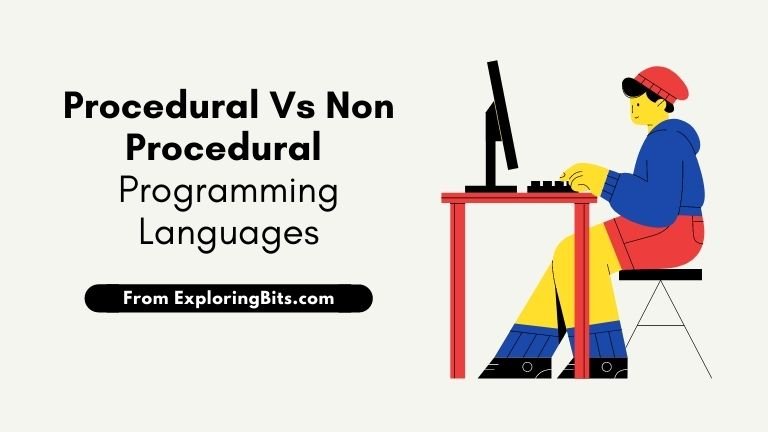The procedural programming languages follow sequences of statements as instruction and therefore require to write more code and also the statements can be executed faster as they are more memory efficient.
The Non procedural programming languages are domain-specific and are developed to fulfill one single purpose and their syntax is more easier to read and understand which makes it less prone to error and easy to learn. It can also perform higher complicated tasks that their domain requires.
Difference between Procedural and Non Procedural Language
Procedural Vs Non Procedural Languages
| Procedural Programming Languages | Non-procedural Programming Languages |
| The procedural language is written as a series of instructions | The non procedural language are written natural language instruction |
| In this language, the programmer has to provide instructions about what is to be done and how it is to be done | In this language, the programmer does only provides information about what is to be done only |
| The procedural language are more command-driven | The non procedural language are more function-driven |
| The return function can only be applied to certain data types | The return function can support any data types and values |
| The length of the procedural programing language is more than non procedural because they have a less predefined library and class | The length of the non procedural programming language is less as due to the presence of rich library and classes |
| These languages are more memory efficient | These languages are less memory efficient |
| These language semantics includes characters, mathematical operator, etc which makes it better than assembly language which used mnemonic codes | This language semantic includes natural language are very simple for a programmer |
| The procedural programming language is focused on an approach for solving the problem | The non procedural programming language is domain-specific such as database, web development, etc |
| The procedural programming can support simple mathematical instructions | The non procedural programming language can support complex mathematical instructions |
| This language support both the iterative loops and recursive calls | This language support only recursive calls |
| The memory location changes as the next statement are executed | The same memory location can execute a series of instruction |
| It depends on the order of execution | It depends on the values of the parameter from the function |
| The reuse of the code concept is not much developed | The reuse of the code concept is present |
| They can execute faster and they require less resource to compile and interpret | They can execute slower because of so many libraries and classes |
| The example of procedural language involves Fortran, Cobol, Fortran, basic, etc. | The example of non procedural language includes java, SQL, C++, etc. |
What is Procedural Programming Language ?
Procedural programming is the first programming paradigm that the new developer will begin with. The procedural code consists of simple instruction directing logical steps to the machine.
Procedural programming is a top-down approach which means that it treats the data and the procedures as two separate entities. As in a procedural call, the procedural programming divides the program into the procedure ( also known as routines) which clearly instructs the set of steps for the execution.
As Quoted by Wikipedia –
Procedural programming is a programming paradigm, derived from structured programming, based on the concept of the procedure call. Procedures (a type of routine or subroutine) simply contain a series of computational steps to be carried out. Any given procedure might be called at any point during a program’s execution, including by other procedures or itself.
Advantages of Procedural Programming Languages
- An excellent general-purpose programming language
- Best suited for compilers and interpreters due to its simplicity
- Portable source code making it platform-independent
- Reusable code without the need to copy
- Easy to track and debug the code
Disadvantages of Procedural Programming Languages
- Heavily relies on blocks and scope
- Greater difficulty in writing the code
- Difficult to relate with a real-world object
- Need to recreate code for different application
- Operations are given more importance over data
- the data is open to the public creating security issues
Examples of Procedural Programming Languages
- FORTRON (Formula Translation)
- COBOL(Common Business-Oriented Language)
- C language
- BASIC (Beginners All-Purpose Symbolic Language)
- Pascal
What is Non Procedural Programming Language ?
In Non-Procedural Programming Languages, the programmer needs to specify “what the program should do” rather than “how the program should perform the task” (the how the part is left up to the language’s implementation rather than programmer’s implementation).
The Non Procedural Languages were preferred over the non procedural languages in higher generation of languages.
As Quoted by Wikipedia –
Declarative programming (Non-Procedural Programming) often considers programs as theories of formal logic, and computations as deductions in that logic space. Declarative programming may greatly simplify writing parallel programs
Advantages of Non-Procedural Programming Languages
- Eliminates the need for a large amount of code to define procedures
- Offer data protected environment
- Highly reusable
Disadvantages of Non-Procedural Programming Languages
- A large amount of memory required
- Slower processing by compiler and interpreters
- The slower speed of the execution
Examples of Non-Procedural Programming Languages
- Java
- C++
- C#
- SQL (Structured Query Language)
Aayush Kumar Gupta is the founder and creator of ExploringBits, a website dedicated to providing useful content for people passionate about Engineering and Technology. Aayush has completed his Bachelor of Technology (Computer Science & Engineering) from 2018-2022. From July 2022, Aayush has been working as a full-time Devops Engineer.
